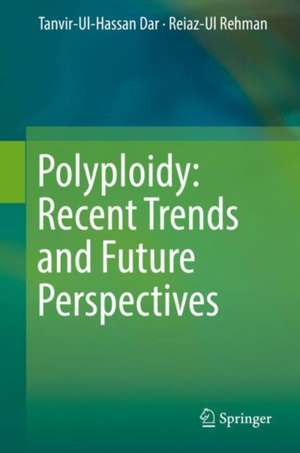Polyploidy: Recent Trends and Future Perspectives
Autor Tanvir-Ul-Hassan Dar, Reiaz-Ul Rehmanen Limba Engleză Hardback – 10 noi 2017
| Toate formatele și edițiile | Preț | Express |
|---|---|---|
| Paperback (1) | 544.62 lei 38-44 zile | |
| Springer India – 6 sep 2018 | 544.62 lei 38-44 zile | |
| Hardback (1) | 550.95 lei 38-44 zile | |
| Springer India – 10 noi 2017 | 550.95 lei 38-44 zile |
Preț: 550.95 lei
Preț vechi: 688.68 lei
-20% Nou
Puncte Express: 826
Preț estimativ în valută:
105.44€ • 114.49$ • 88.57£
105.44€ • 114.49$ • 88.57£
Carte tipărită la comandă
Livrare economică 19-25 aprilie
Preluare comenzi: 021 569.72.76
Specificații
ISBN-13: 9788132237709
ISBN-10: 8132237706
Pagini: 104
Ilustrații: IX, 104 p. 20 illus., 17 illus. in color.
Dimensiuni: 155 x 235 mm
Ediția:1st ed. 2017
Editura: Springer India
Colecția Springer
Locul publicării:New Delhi, India
ISBN-10: 8132237706
Pagini: 104
Ilustrații: IX, 104 p. 20 illus., 17 illus. in color.
Dimensiuni: 155 x 235 mm
Ediția:1st ed. 2017
Editura: Springer India
Colecția Springer
Locul publicării:New Delhi, India
Cuprins
Chapter1. Introduction to Polyploidy.- Chapter2. Origin of Polyploidy.- Chapter3. Occurrence of Polyploidy.- Chapter4. Detection of Polyploidy.- Chapter5. Significance of Polyploidy.- Chapter6. Polyploidy and Genomic Changes.- Chapter7. Polyploidy and its impact on changing environment.- Chapter8. Future Perspective.
Notă biografică
Dr. Tanvir-Ul-Hassan Dar PhD is presently working as an assistant professor at the School of Biosciences and Biotechnology, Baba Ghulam Shah Badshah University, Rajouri (Jammu & Kashmir). He completed his master’s degree in Biotechnology at the University of Kashmir, Srinagar, and obtained his M. Phil and Ph. D from the University of Delhi. Subsequently, he had one year of post-doctorate research training at the National Institute of Plant Genome Research (NIPGR), New Delhi. Dr. Dar has five years of teaching experience at post-graduate level and is currently involved in supervision of M. Phil and Doctorate students. With specialization in polyploidy, he has acquired the necessary training and experience to carry out research in this field of biological sciences. He has published more than 15 research papers in peer-reviewed national and international journals; attended numerous seminars, conferences and workshops; and is a member of several important academic and scientific bodies. Reiaz Ul Rehman PhD – is currently an assistant professor at the Department of Bioresources, School of Biological Sciences, University of Kashmir and is actively involved in teaching master’s and integrated PhD students. He earned his master’s and PhD in Plant Biology at Hamdard University, New Delhi and has worked as a postdoctoral research fellow at the University of Louisville (Kentucky, USA), University of Salento (Lecce, Italy). He is a recipient of the prestigious Marie Curie International Incoming Fellowship (IIF) (Lisbon, Portugal). His research interests include characterization of the physiological and metabolic processes in underutilized crops challenged with stresses and he has published 40 research articles and one edited book.
Textul de pe ultima copertă
This is the first book to present consolidated, up-to-date information regarding recent trends and future perspectives of polyploidy – a phenomenon that has played a pivotal role in the evolution of domesticated plants and a research area that has been given new impetus thanks to advances in plant biology techniques integrated with bioinformatics tools. The book emphasizes the tremendous potential of polyploidy in plant breeding to improve existing crops and develop new ones to cater for the needs of an ever-increasing human population. It is divided into 8 chapters, each including an introduction and references, and complemented with plentiful illustrations, figures and tables. The chapters cover all facets of polyploidy, from its origin, occurrence, recent polyploidization, formation pathways, artificial induction, criteria for detection, and its significance in the contexts of genomic changes and the changing environment, as well as future perspectives. The book discusses at lengththe aspects of polyploidy that need to be understood for a thorough comprehension of this biologically important subject. It also highlights the recent techniques involved in polyploidy research. Further, it provides a detailed account, with suitable examples, of the different genetic and epigenetic changes that occur in polyploids to help their survival.
A timely publication, it serves as an excellent single-source textbook. It is a valuable resource for students, research scholars and teachers of biological sciences in particular, and to plant breeders, cytologists, geneticists, and molecular biologists in general.
Caracteristici
Gives consolidated, up-to-date information on polyploidy during the last one hundred years since its discovery Special emphasis on recent studies on the genomic effects and evolution of polyploids using molecular techniques? Presents polyploidy as a universal phenomenon right from algae to most advances angiosperms
